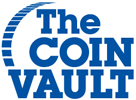Released in 2023, Whitman Publishing’s 3rd edition of the 100 Greatest Ancient Coins by Harlan J. Berk is the subject of our next blog series.
The coins compiled on this list were voted into place by a survey of acclaimed museum curators, coin dealers, researchers, collectors, and historians. The entries voted upon demonstrate historical significance in addition to rarity, value, popularity, eye appeal, and more characteristics that make them great.
Ancient coins hold a compelling and meaningful role in numismatics. While they may be a very specific collector niche today, they are ultimately responsible for the beginning of coinage. In a time when the Near East and its developed states remained centralized enough when it came to the economic exchange of goods, coinage was not needed as Sumerians and Egyptians continued to use barter in commercial climates even though silver would eventually come into play. It was not until around 650 B.C. that the development of coinage took place by Greeks and the Lydians, in what is now parts of Turkey, after realizations that their civilizations would need more organization due to their lack of centralization in the Near East. Economic opportunity was scarce, and bartering was much too unwieldy for the growing financial transactions involving silver.
The first coins were made up of an alloy comprised of gold and silver that occurred naturally in deposits called electrum. Soon these “lumps” of electrum started to develop designs and the metals would eventually bear the trace of the punches used to strike the die. Over time, obverses and reverses would depict animals and human resemblance while their inevitable fate lay in the hands of monarchies that would eventually decide to “corner the market” on the issuance of the coins.
To read more about ancient coins and collecting, refer to The Roundtable blog For the Love of Ancients written in April of 2019.
This blog series will explore, along with help from Berk, the top 100 to not only make the list as voted on, but the benefits of collecting such coins. There is much to consider when it comes to ancient coins, but the most important thing to note is that research is and will always be the biggest component in your success as an ancient collector.
We look forward to journeying back in time throughout this series with you and learning more about the history of numismatics.
Source: 100 Greatest Ancient Coins by Harlan J. Berk (Whitman Publishing)
